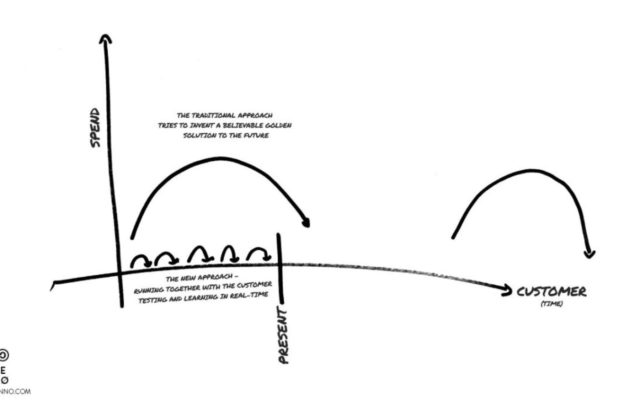Right now I mostly freelance, and at a given time I’m maybe working with 12-15 different companies of all sizes. Everyone, and I mean everyone, talks about their strategic road map. It’s the absolute standard bearer for breathless business analysis at most places. “We have a strategic road map,” the theory goes, “so by definition we’re strategic, and subsequently we will make a bunch of money and prove lots of growth to our investors!”
In reality, none of that is true — and honestly, constantly talking about your strategic road map makes you sound like a total d-bag. Let’s break this down a little bit further if we can.
The strategic road map: What should it be?
This one is hard for a lot of people. Most people in decision-making roles at companies confuse “strategy” with “operations.” Let’s make it simple: strategy is what you intend to do (and why), whereas operations is how (and where) you will do those things. They are by no means the same, but a lot of people fail to realize that. When we often discuss our “strategic planning initiatives,” we’re leaving a ton out.
So, what should a strategic road map look like?
IMHO:
- Some priority definition: Many companies are absolutely terrible at “This is a priority and this is not,” which allows many “Everything has a sense of urgency” managers to rise up. There’s nothing good about that. It just creates stress for most employees. (See also: “Inbox Zero, discussions about.”)
- Strategy and execution: Normally, executives set the strategy for an organization. (Not surprising.) But because most offices are a giant game of telephone, that strategy hardly trickles down properly to regular employees. As such, you’ve got people coming in Wednesday AM working on low-priority sh*t and thinking it matters. It does not matter. You can’t have a strategic road map if 7 in 10 employees don’t work on relevant deliverables. All you have then is a dumpster fire. It’s hardly strategic, nor a road map.
- Who plays what role? If you’re a major fan of the tech scene, former Intel CEO Andy Grove once said this about managers. “Their only role is to facilitate the hand-off of projects from Group A to Group B.” Most current managers would pound their chests re: their importance at that statement — “I’m a target-hitter, Bill! I make the trains move and bring in the money!” — but in reality, many managers are worthless. We all somewhat understand this. If you really want a strategic road map, design it so that managers are helping vs. getting in the way. In most cases, it’s the latter.
The strategic road map: Ever heard of agility?
I’ve worked (full-time and freelance) at probably 19 places that have someone with the word “agility” or “agile” in their job title. This is a major business development fad (yes, ’tis a fad) of the last two-three decades. The thinking is: if you’re agile, you’re nimble. And if you’re nimble? You can hit targets in a variety of situations. That must be good for business, right?!? Right!
Wrong.
Here’s the problem with the “strategic road map” at most companies: once the road map is set, it’s intractable. That’s the opposite of agile. So a bunch of people work on this strategic road map for weeks/months, and then it’s set and approved. At that point, if a business need changes, the road map often can’t subsequently changed. “That’s out of scope,” someone will bellow. “We’ve already begun sprints and work assignments,” another will yelp.
Use the words “road map.” Now think about this. Let’s say you’re driving from New York to Philadelphia. You are using a map. Waze, a technology, tells you that a 18-wheeler overturned on I-95. You decide to use local roads to get to Philly quicker.
You just called an audible. In essence, you were agile. There was a concern regarding your outcome/goals, and you adjusted to meet that concern. That’s a very logical series of steps and decision-making. At no point did you say “I must stay on I-95 because that is my strategic road map.”
Now, individuals and companies are different inherently — but companies stay the course all the time. Why is this, though?
The strategic road map and process
In short, it’s because they cherish process — especially “process for the sake of process.” This ultimately murders business results, but no one cares.
The point of most process is really this:
- Protect the upper levels from doing work
- Divest anyone from making a real decision
- Make sure you know who to chuck under a train if a target isn’t hit
If you ever work at a place that tells you a strategic road map can’t be edited once it’s set due to a variety of process reasons, you’re working at the wrong place. Strategy, by definition, is fluid. It’s a response to customers’ needs/wants and market conditions. If it’s locked in beyond a shadow of a doubt, it’s not strategy. It’s just garbage f*rt process.
The douchebag nature of people who constantly say “Strategic road map”
You’ve all worked with this person. In many cases, they’re not describing strategy — they’re describing a series of boxes that need to be checked. (Again, that’s operations, not strategy.) I sometimes think people use terms like “strategic road map” because it makes them feel more adult or professional or business-like. In reality, they probably have little idea what they’re saying or what it really means. “Everyone else seems to be using this term, and I want to fit in, so I shall as well!”
It’s pretty annoying and dithering, but it happens at companies of all sizes.
How do we improve the idea of a strategic road map?
Mostly addressed this above. The cheat sheet:
- Set clear priorities and goals
- Align big-picture with day-to-day work
- Make sure your strategy approach is fluid and not locked in
- Don’t be beholden to process as a religion
- It can be set at the upper levels but needs to be evaluated at other levels
- Have metrics in place, even if as simple as “Is this making money for us?”
- Stop using the term as a catch-all for everything from “updating Excel documents” to “leadership off-sites”
- Understand what a map actually is; namely, it’s a way to reach your goals that often is adjusted on the fly
- Stop having your no-context hiring process ID peeps as “strategists” when all they do is digitally push papers from A to B
In short, then: a strategic road map requires an understanding of actual strategy, as opposed to just pounding your chest and blabbering about it. Does your company have that?
My name is Ted Bauer. I’d love to help you out.
Article by channel:
Everything you need to know about Digital Transformation
The best articles, news and events direct to your inbox
Read more articles tagged: Featured, Operating Model, Strategy






